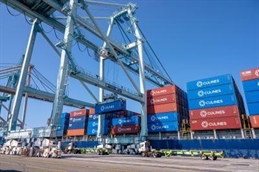
The Port of Long Beach said it kicked off the new year with its busiest January on record, boosted by efforts to successfully move aging cargo out of shipping terminals.
In a statement, the port — which is the second-busiest container seaport in the United States — said dockworkers and terminal operators moved 800,943 twenty-foot equivalent units (TEUs) in January, up 4.8% from the same month last year.
Imports rose 6.9% to 389,334 TEUs, while exports increased 5.9% to 123,060 TEUs. Empty containers moved through the Port grew 1.8% to 288,550 TEUs.
"It was the first time the nation's second-busiest seaport processed more than 800,000 TEUs in the month of January, surpassing the previous record set in January 2021," the port said.
The strong start to 2022 follows a record-breaking year for the Port of Long Beach with 9,384,368 TEUs moved last year.
"Terminal capacity is finally opening up thanks to support from our federal and state leadership, collaboration with industry partners, and the hard work of the men and women moving record amounts of cargo off the docks," said Mario Cordero, Port of Long Beach executive director.
"We expect to remain moderately busy into the spring as we make significant progress to clear the docks and process the backlog of vessels waiting off shore."
For his part, Steven Neal, Long Beach Harbor Commission President attributed the "record-breaking" growth to waterfront workers, who he said, have quickly process goods moving through the Port.
"We anticipate this momentum to continue through 2022, allowing us to remain a leader in trans-Pacific trade," Neal said.
Port of Long Beach noted that import activity traditionally slows down in February as overseas factories close for Lunar New Year celebrations, but this month may be "busier than usual" as work continues to clear the docks and reduce the number of ships waiting to enter the Port amid a historic cargo surge.
The Port, along with Port of Los Angeles, earlier announced the delay of the start of a "Container Dwell Fee" that would charge ocean carriers for containers that remain too long on the docks citing improvement in movement of goods out of the port.
The San Pedro Bay ports – Long Beach and Los Angeles combined – said it have seen a 68% decline in aging cargo on the docks since the program was announced on October 25.
Port of Long Beach alone handled trade valued at more than US$200 billion annually.



